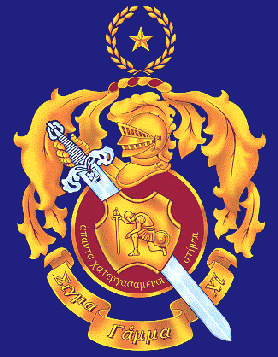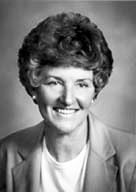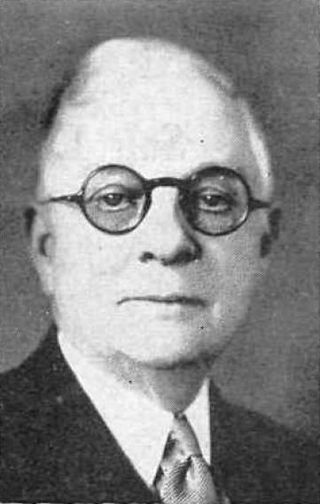History
In the early years of the Institute of Religion at the University of Utah, attendance was growing and some male students wanted a way to build their brotherhood with fellow Latter-day Saints. Lowell L. Bennion, the institute director, helped them prepare a constitution and organized them as "Alpha House" in October 1936, followed by "Omega House" for women in December. Shortly afterward, these houses were collectively named Lambda Delta Sigma, which would be a co-educational Greek society open to anyone willing to uphold Latter-day Saint ideals. [2]
In 1966 following a study by Paul H. Dunn, the LDSSA was formed and Lambda Delta Sigma was dissolved. [3]
Elaine Cannon, Winnifred Jardine, Frank Bradshaw and Alfred Nielsen were called by the general authorities to make plans for a new LDS sorority and divided the organization, making Lambda Delta Sigma a sorority and creating Sigma Gamma Chi as its fraternity. [4] [3] Elaine Cannon was called as the new national advisor, and wrote the Pledge Ceremony, Initiation Ceremony and selected other symbols for the group.
In November 1967, this new Lambda Delta Sigma was approved at the first National Convention of the LDSSA. In 1977, the sorority was transferred to the leadership of the Relief Society General Presidency and the national LDS President served on the General Relief Society Board and by 1982, all Lambda Delta Sigma officers gained National Board positions.
In June 2000 it was announced that in September, the sorority was to absorbed by the Institute Women's Association, a church organization for all female Young Single Adults. [5]

The Relief Society is a philanthropic and educational women's organization of the Church of Jesus Christ of Latter-day Saints. It was founded in 1842 in Nauvoo, Illinois, United States, and has more than 7 million members in over 188 countries and territories. The Relief Society is often referred to by the church and others as "one of the oldest and largest women's organizations in the world."
Cultural interest fraternities and sororities, in the North American student fraternity and sorority system, refer to general, social organizations oriented to students having a special interest in a culture or cultural identity.
A fireside is a supplementary, evening meeting in the Church of Jesus Christ of Latter-day Saints.

Sigma Gamma Chi (ΣΓΧ) was a fraternal organization sponsored by the Church of Jesus Christ of Latter-day Saints. Although it once was a national organization, it later only operated at the University of Utah where it was established in 1967. The last chapter closed in 2011.
Edwin Bennion "Ted" Cannon was an American attorney who served as a member of the Utah State Senate from 1951 until 1954 as a member of the Republican Party.
Delta Phi Kappa may refer to:
The Young Women is a youth organization of the Church of Jesus Christ of Latter-day Saints. The purpose of the Young Women organization is to help each young woman "be worthy to make and keep sacred covenants and receive the ordinances of the temple."
Barbara Ann Woodhead Winder was the eleventh general president of the Relief Society of the Church of Jesus Christ of Latter-day Saints from 1984 to 1990.

Elaine Anderson Cannon was the eighth general president of the Young Women organization of the Church of Jesus Christ of Latter-day Saints from 1978 to 1984. Cannon was a writer and an editor and the author of over fifty books.
Lambda Delta Sigma may refer to:

Louisa Lula Greene Richards was a poet and was the first female periodical editor in Utah Territory. Richards's work was published under a variety of names, including Louisa L. Greene, Louise L. Green, Lula Green, and Lula G. Richards. She was a member of the Church of Jesus Christ of Latter-day Saints.

Milton Bennion was an American educator and a university and educational administrator.
George Richard Hill Jr. was an American educational administrator and was the seventh general superintendent of the Sunday School organization of the Church of Jesus Christ of Latter-day Saints from 1949 to 1966. Hill was a member of the general superintendency of the LDS Church Sunday School from 1934 to 1966.

Levi Edgar Young was a general authority of the Church of Jesus Christ of Latter-day Saints. He was one of the seven presidents of the Seventy from 1909 until his death. He has been associated with the release of the 1832 account of Joseph Smith's First Vision, which was previously not widely known. Aside from his service in the Seventy, Young served as president of various LDS Church missions. Young received a master's degree from Columbia University in history and was a professor of history at the University of Utah.
Lowell Lindsay Bennion was an American educator, sociologist, and humanitarian. He wrote extensively on religious living in the Church of Jesus Christ of Latter-day Saints, and was an advocate for volunteer service in Utah and Idaho.

Mary Ellen Edmunds is an American religious public speaker, author, and nurse. A member of the Church of Jesus Christ of Latter-day Saints, she was the Director of Training in the Missionary Training Center in Provo, Utah 1978–1995. She also served as a member of the Relief Society general board. Edmunds also served as an LDS missionary in Taiwan, Hong Kong, the Philippines, and Indonesia. She was the director of the Thrasher International Program for Children in Nigeria for a short time.

Delta Phi Kappa (ΔΦΚ), was a fraternity for male returned missionaries of the Church of Jesus Christ of Latter-day Saints at colleges in Utah, Idaho, and Arizona. It existed from 1920 to 1978.
This page is based on this
Wikipedia article Text is available under the
CC BY-SA 4.0 license; additional terms may apply.
Images, videos and audio are available under their respective licenses.








